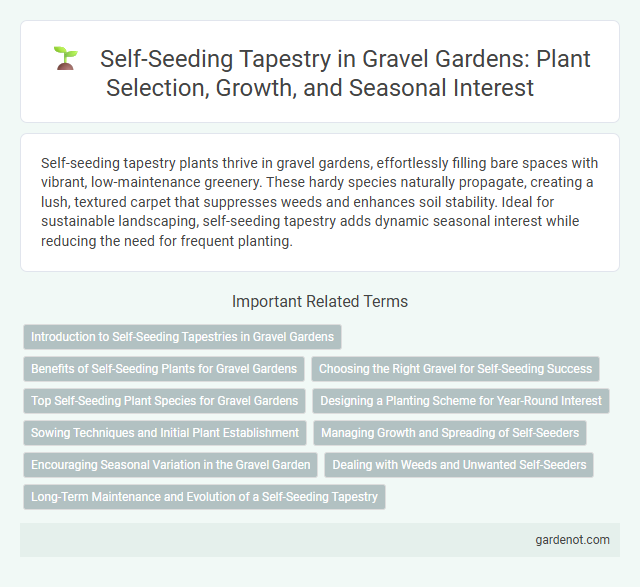Self-seeding tapestry plants thrive in gravel gardens, effortlessly filling bare spaces with vibrant, low-maintenance greenery. These hardy species naturally propagate, creating a lush, textured carpet that suppresses weeds and enhances soil stability. Ideal for sustainable landscaping, self-seeding tapestry adds dynamic seasonal interest while reducing the need for frequent planting.
Introduction to Self-Seeding Tapestries in Gravel Gardens
Self-seeding tapestries in gravel gardens create dynamic, low-maintenance displays by allowing plants to naturally disperse and establish over time. These living carpets support biodiversity by attracting pollinators while minimizing the need for replanting and irrigation. Gravel garden environments favor hardy species like thyme, sedum, and wildflowers that thrive with minimal soil and water.
Benefits of Self-Seeding Plants for Gravel Gardens
Self-seeding plants in gravel gardens enhance biodiversity by attracting pollinators and providing continuous ground cover without the need for replanting. These resilient species reduce maintenance efforts and water usage, making gravel gardens more sustainable and eco-friendly. Their natural spread quickly fills gaps, creating a dynamic and evolving landscape that thrives in well-drained, nutrient-poor conditions.
Choosing the Right Gravel for Self-Seeding Success
Selecting the appropriate gravel size and composition is crucial for promoting self-seeding in gravel gardens, as well-draining substrates encourage seed germination and root establishment. Opt for angular, coarse gravel between 6-12mm to balance moisture retention and air circulation, creating an ideal microenvironment for seedling growth. Avoid overly fine or compacted gravel that can inhibit seedling emergence and reduce overall plant diversity in the gravel garden tapestry.
Top Self-Seeding Plant Species for Gravel Gardens
Top self-seeding plant species for gravel gardens include Alyssum saxatile, known for its bright yellow flowers and drought tolerance, and Erysimum cheiri, which offers vibrant blooms and thrives in well-drained soils. Other excellent options are Cerastium tomentosum, appreciated for its silvery foliage and white flowers, and Papaver rhoeas, or corn poppy, which brings striking red blossoms that easily reseed. These species create a low-maintenance, resilient tapestry that enhances gravel garden aesthetics while requiring minimal intervention.
Designing a Planting Scheme for Year-Round Interest
Selecting a diverse mix of self-seeding plants such as carnations, poppies, and wallflowers ensures continuous bloom and dynamic texture throughout the seasons in a gravel garden. Incorporating species with staggered flowering times and varied foliage colors enhances visual interest while minimizing maintenance. Designing a planting scheme around these resilient plants creates a sustainable tapestry that thrives in well-drained, low-nutrient soils common in gravel gardens.
Sowing Techniques and Initial Plant Establishment
Effective sowing techniques for a self-seeding tapestry in a gravel garden involve scattering seeds thinly over well-prepared, weed-free soil with good drainage to ensure optimal germination. Lightly pressing seeds into the substrate without burying them too deeply helps maintain moisture while allowing seedlings to emerge easily. Initial plant establishment relies on consistent watering during dry periods and minimal disturbance to encourage strong root development and natural reseeding cycles.
Managing Growth and Spreading of Self-Seeders
Managing the growth and spreading of self-seeding tapestry plants in a gravel garden involves regular monitoring to prevent overcrowding and maintain plant health. Strategic thinning and selective removal of seedlings help control expansion while encouraging robust, healthy growth. Mulching and targeted watering further support optimal conditions, reducing weed competition and enhancing seedling establishment.
Encouraging Seasonal Variation in the Gravel Garden
Self-seeding plants such as poppies, cornflowers, and wild thyme create dynamic seasonal variation in gravel gardens by naturally spreading throughout the space. These resilient species adapt well to well-drained, nutrient-poor soils typical of gravel beds, ensuring continuous blooms from spring to autumn. Their natural reseeding promotes biodiversity and low-maintenance growth, making the gravel garden visually vibrant year-round.
Dealing with Weeds and Unwanted Self-Seeders
Effective management of self-seeding tapestry in gravel gardens requires regular monitoring to identify and remove weeds and unwanted seedlings early. Applying a thin layer of mulch or gravel can suppress weed germination while allowing desired plants to thrive. Selective hand-weeding and targeted herbicide use help maintain the aesthetic and health of the gravel garden ecosystem.
Long-Term Maintenance and Evolution of a Self-Seeding Tapestry
A self-seeding tapestry in a gravel garden evolves through natural succession, requiring minimal long-term maintenance as native plants establish and spread autonomously. Periodic monitoring aids in controlling invasive species and maintaining biodiversity balance to ensure ecological resilience. Over time, this dynamic tapestry enhances soil health and garden aesthetics with minimal human intervention.
Self-seeding tapestry Infographic

 gardenot.com
gardenot.com